- How Injectors Work
- Choosing an Injector
- Installation Considerations
- Calibrating an Injector
- Laws and Regulations Concerning Water Supply Protection in Georgia
- Bibliography
- Appendix
Fertilizer injectors are devices used to apply water-soluble fertilizers, pesticides, plant growth regulators, wetting agents and mineral acids during crop production. They are a vital part of modern greenhouse or nursery operations. Since the introduction of injectors or proportioners, growers have enjoyed an easy time- and labor-saving method of applying liquid chemical solutions to their crops. Despite the advantages, many growers have had at least one experience with a compromised, damaged or even ruined crop where the cause was traced to a malfunctioning injector. Just like other mechanical devices, proper and frequent maintenance and calibration are crucial steps to ensure optimal injector performance and, thus, healthy crops.
How Injectors Work
Injectors take a small portion of concentrated fertilizer solution from a stock tank and inject it into the water line. For every part of stock solution, there are x parts of water, where "x" is determined by the injector ratio. For example, with a 1:100 ratio 1 part of stock solution is mixed with 99 parts of water, for a total of 100 parts of final solution. The size of the stock tank varies and it could be as small as 5 gallons or as large as 2,000 gallons. Often ratios are expressed as percent. For example, a 1:100 ratio equals a 1 percent solution. (See "Fertilizer Injector or Proportioner" illustration below.)
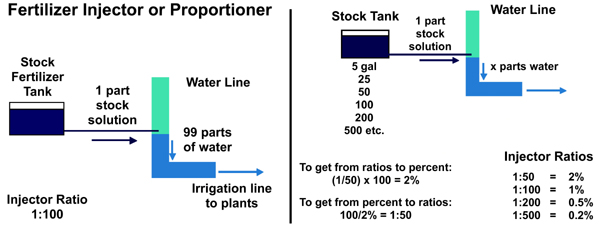
Injectors work on one of two principles.
Venturi-type injectors, such as Hozon and Syphonex (Figure 1) use a pressure difference between the water line and the stock tank to draw a concentrated solution into a faucet connect valve and mix it with water in the hose. These inexpensive injectors can be easily attached to any faucet but do not allow precise control over concentration. Because of water pressure fluctuations variable amount(s) of chemical may be injected into the hose. In addition, the injection ratios are low (typically 1:16) and therefore require a large stock tank, thus limiting the use of Venturi-type injectors to small growing areas. The Hozon requires very little maintenance; check the screen on the suction line for clogs and periodically remove salt deposits from the mixing valve.
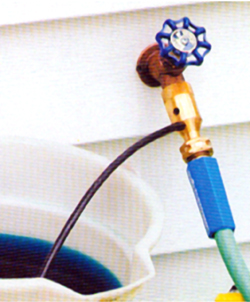 Figure 1A: A Hozon is a small brass mixing valve that screws onto the faucet and has a hose attached to it. As water passes through the Hozon, it creates a suction that draws fertilizer solution from a concentrate tank. It needs a minimum 35 psi (pounds per square inch) water pressure for proper operation. Besides fertilizer, it can be used to dispense insecticides, fungicides and other water-soluble chemicals through a hose. (Photo: Hummert Int'l. Catalog 2003)
Figure 1A: A Hozon is a small brass mixing valve that screws onto the faucet and has a hose attached to it. As water passes through the Hozon, it creates a suction that draws fertilizer solution from a concentrate tank. It needs a minimum 35 psi (pounds per square inch) water pressure for proper operation. Besides fertilizer, it can be used to dispense insecticides, fungicides and other water-soluble chemicals through a hose. (Photo: Hummert Int'l. Catalog 2003)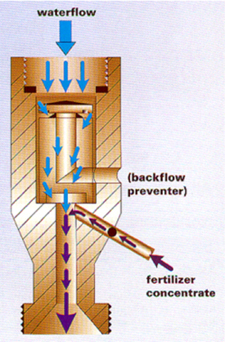 Figure 1B: The Hozon has an injection ratio of 1:16. For each gallon of concentrate taken up, it produces 16 gallons of liquid fertilizer solution. The Hozon draws 1 gallon of concentrate in about 5 minutes, and this will be mixed with approximately 12 to 18 parts of water through the hose, i.e., 5/8 in. instead of ½ in., produces a higher flow rate. Excessive back-pressure will cause the siphon to stop drawing. The Hozon should not be more than 50 ft from the nozzle end to work properly. If more than 50 ft of hose is used, the Hozon can be connected between two sections of hose. (Photo: Hummert Int'l. Catalog 2003)
Figure 1B: The Hozon has an injection ratio of 1:16. For each gallon of concentrate taken up, it produces 16 gallons of liquid fertilizer solution. The Hozon draws 1 gallon of concentrate in about 5 minutes, and this will be mixed with approximately 12 to 18 parts of water through the hose, i.e., 5/8 in. instead of ½ in., produces a higher flow rate. Excessive back-pressure will cause the siphon to stop drawing. The Hozon should not be more than 50 ft from the nozzle end to work properly. If more than 50 ft of hose is used, the Hozon can be connected between two sections of hose. (Photo: Hummert Int'l. Catalog 2003)
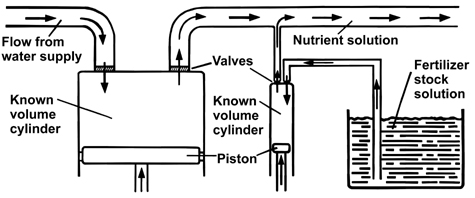 Figure 2. Positive displacement pump injector. Source: Water and Nutrient Management for Greenhouses (NRAES-56)
Figure 2. Positive displacement pump injector. Source: Water and Nutrient Management for Greenhouses (NRAES-56)Positive displacement injectors, such as Dosatron, DosMatic, Anderson, Smith, and Gewa products provide consistent injection ratios for the designed flow rates over wide variations in water pressure. A measured amount of stock solution, determined by filling a specifically sized chamber, is injected into the irrigation water, the rate of which also is controlled by the unit (Figure 2). The limiting factor in these injectors, in most cases, is the minimum and maximum water flow rate permissible. However, the industry offers models that can accommodate a wide range of flow rates. The injection ratio depends on the size of cylinders and the relative rate of displacement of fluid in the cylinders by the pistons. Precise control over the amount of injected chemicals, smaller stock tanks and broader injection ratios have made positive displacement injectors an industry standard.
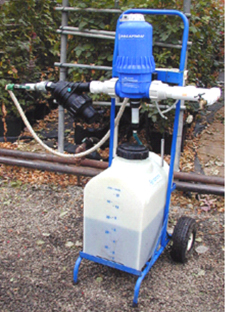 Figure 3. Maximum flow rates for Dosatron injectors range from 7 gpm to 264 gpm for various models, with ratios ranging from 1:50 to 1:500 for smaller flow rates, from 1:50 to 1:500 or 1:1000 for larger flow rates. The ratio can be easily adjusted on the outside of the injector. Dosatron injectors may be installed in a variety of system configurations in addition to being put directly in the water line. Special configurations allow flushing clean water (by-pass), injecting multiple solutions (series), and increasing water flow (parallel). Consult technical experts or check the Dosatron website (Table 4) for installation configurations.
Figure 3. Maximum flow rates for Dosatron injectors range from 7 gpm to 264 gpm for various models, with ratios ranging from 1:50 to 1:500 for smaller flow rates, from 1:50 to 1:500 or 1:1000 for larger flow rates. The ratio can be easily adjusted on the outside of the injector. Dosatron injectors may be installed in a variety of system configurations in addition to being put directly in the water line. Special configurations allow flushing clean water (by-pass), injecting multiple solutions (series), and increasing water flow (parallel). Consult technical experts or check the Dosatron website (Table 4) for installation configurations.Dosatron injectors (Figure 3). These injectors operate without electricity, using water pressure as the power source. They are installed directly in the water supply line. Water flow activates the injector, which takes up the required percentage of concentrate directly from a container with stock solution. Inside the injector, concentrate is mixed with water, and water pressure forces the solution downstream. The amount of concentrate dispensed is directly proportional to the volume of water entering the injector, irrespective of variations in water flow or pressure that may occur in the main line. Standard Dosatron units do allow for injection of most acids (depending upon the concentration of the acid and water temperatures); however, the concentration of injected acid should not exceed 5 percent. Stronger acids can be injected if units containing PVDF (Polyvinylidene Fluoride) parts, or other options for injecting corrosive materials are in place.
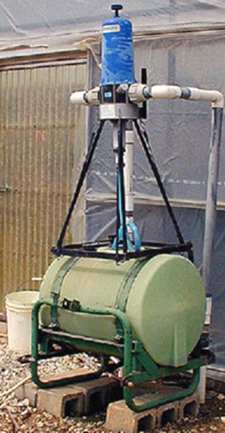 Figure 4. Maximum flow rates for DosMatic injectors range from less than 1 gpm to 100 gpm with ratios from 1:10 to 1:4000 on various models. The injection ratio can be adjusted while in use. A wide range of combinations of water flow and injection ratios can be accommodated, e.g., low flow and low injection, low flow and high injection to high flow and low injection, and high flow and high injection.
Figure 4. Maximum flow rates for DosMatic injectors range from less than 1 gpm to 100 gpm with ratios from 1:10 to 1:4000 on various models. The injection ratio can be adjusted while in use. A wide range of combinations of water flow and injection ratios can be accommodated, e.g., low flow and low injection, low flow and high injection to high flow and low injection, and high flow and high injection.DosMatic injectors (Figure 4). DosMatic injectors also operate without electricity, using water pressure as the power source. They are installed directly in the water supply line. The water activates the injector, which takes up the required percentage of concentrate directly from a container with stock solution. Inside the injector, the concentrate is mixed with the water, and the water pressure forces the solution downstream. The amount of concentrate is directly proportional to the volume of water entering the injector, irrespective of variations in water flow or pressure, which may occur in the main line. The standard DosMatic units allow for injection of most acids and disinfectants. There are Advantage models specially designed for water pH adjustment, and others that allow remote injection of chemicals downstream for in-series application.
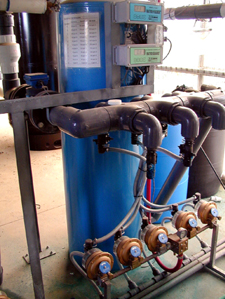 Figure 5. H.E. Anderson injector with multiple fertilizer injector heads.
Figure 5. H.E. Anderson injector with multiple fertilizer injector heads.Anderson injectors (Figure 5). The Anderson Ratio:Feeder injectors feature positive displacement and volume proportioning by either a flow metered electric pump or water pressure, depending on the model. The original Series S is water driven while the intermediate Series J-Plus are electric units. The design of Anderson injectors permits wide water flow ranges with minimal pressure loss. There are no sliding seals in the pumping mechanism as well as no metal in contact with the chemical (stainless check balls are used with fertilizers and some acids). All units have adjustable feed ratios from 1:50 to higher than 1:1000 on various models. The injection ratio can be adjusted while the injector is in use. All units operate with a water pressure range of 15 to 125 psi and flow rates range from less than 1 gpm to higher than 1000 gpm. A mixing tank is often plumbed in-line between the point of concentrate injection and delivery to the crop. Multiple fertilizer injector heads are possible (up to six).
Smith Injectors. The Smith Measuremix injectors operate on water power and require no electric motor or gasoline engine. Water passing through the water motor provides the power to run the injector pump. The water motor actually meters the water running through the unit. For every revolution of the water motor, there is one stroke of the injector pump. The proportion of water to chemical solution remains the same, regardless of changes in water pressure. The Smith Measuremix injectors are built to dispense a variety of liquid chemicals. The water motors are made of bronze and stainless steel, while the injector pistons are built of stainless steel on all models, and valves and fittings in the injector system are stainless steel on standard models. The units are permanently set at proportion ratios of 1:100 or 1:200 (on some models 1:50 and 1:150 ratios also are available). Their flow rates, which go up to 700 gpm, allow simultaneous fertil-ization of numerous benches and an entire greenhouse range. Models that accommodate flow rates higher than 200 gpm have injection ratios of 1:800 to 1:4000.
Some models are two-injectors-in-one and allow simultaneous injection of two chemical mixes. Smaller units, such as the model R-1, are designed for portable hand watering applications as well as permanent installation and accommodate flow ranges from 2 to 12 gpm. Built almost entirely from plastics, the R-1 can be used to inject any combination of liquid fertilizers, fungicides, chelates, insecticides or mild acids. The Smith Measuremix injectors have a history of being very accurate and dependable. There is virtually no maintenance other than flushing the fertilizer out of the machine after each use.
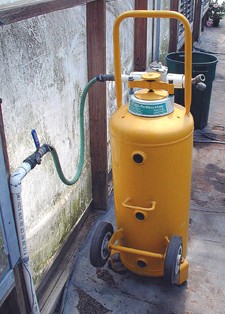 Figure 6. Gewa injectors are available in several sizes ranging from 4 gallons to 26 gallons. Depending on the model, they have proportioning ratios of 1:100 up to 1:300. The 15 different settings, 1:300 to 1:20 on the valve, are accurate to within 4 percent. A thick steel tank makes up the bulk of the Gewa. A system water flow of 1.6 gpm up to 88 gpm and systen pressures up to 125 psi are required. The injectors are made with wheels and are easily movable.
Figure 6. Gewa injectors are available in several sizes ranging from 4 gallons to 26 gallons. Depending on the model, they have proportioning ratios of 1:100 up to 1:300. The 15 different settings, 1:300 to 1:20 on the valve, are accurate to within 4 percent. A thick steel tank makes up the bulk of the Gewa. A system water flow of 1.6 gpm up to 88 gpm and systen pressures up to 125 psi are required. The injectors are made with wheels and are easily movable.Gewa injector (Figure 6). Gewas are manufactured in Germany and have been distributed in the United States since 1949. This injector has no suction or pumping device, and the concentrated fertilizer solution is forced into the water line by the water pressure. The concentrate is poured inside the injector into a plastic membrane suspended inside of the tank and the lid is sealed shut. When the tap water is turned on, it surrounds the membrane and applies pressure to the bag, which forces a calibrated amount of concentrate into the water line. During operation, the plastic bag on the inside of the Gewa folds down on itself. Because the stock solution has a higher specific weight than water, the folding in takes place from the top down.
It is important to insure that the center tube is in place during operation to prevent the membrane from sealing off the flow of solution. The only moving part in the GEWA is the float in the valve. This bronze, spring loaded float measures water flow on the inlet side of the valve. A sudden loss in water pressure or flow does not affect the proportioning of the valve. Periodically the inner membrane must be replaced and that requires disassembling the unit. Caution must be used when opening and closing the Gewa so the top cover is not improperly closed or bent.
EC and pH Controllers. Electrical Conductivity (EC) and pH controllers offer a wide range of management options for optimizing the nutritional program and the root zone environment. Desired EC levels can be achieved by pumping fertilizer from one to several stock tanks into the mixing tank (Figure 7A). pH levels are achieved by injecting acid or base into the mixing tank from one or more stock tanks.
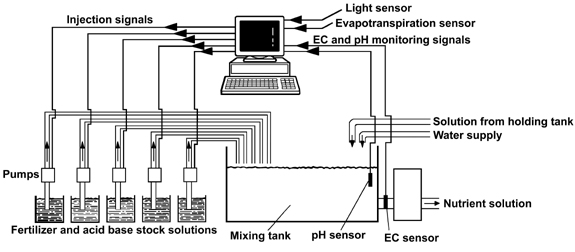 Figure 7A. EC and pH controller. Source: Water and Nutrient Management for Greenhouses (NRAES-56)
Figure 7A. EC and pH controller. Source: Water and Nutrient Management for Greenhouses (NRAES-56)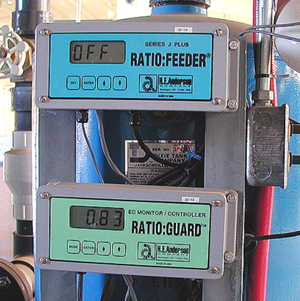 Figure 7B. Anderson's Ratio:Guard controller used with Anderson's Ratio:Feeder injector system. Monitors and probes can be installed in-line for constant reading of pH and Electrical Conductivity (EC) of the fertilizer solution being injected into the water line.
Figure 7B. Anderson's Ratio:Guard controller used with Anderson's Ratio:Feeder injector system. Monitors and probes can be installed in-line for constant reading of pH and Electrical Conductivity (EC) of the fertilizer solution being injected into the water line.
Choosing an Injector
Choose an injector after some important factors have been considered.
Size of the operation.
The needs of small size operations, less than and up to 10,000 square feet, can be serviced with smaller units.
Type of fertility programs.
Base your fertility program on the types of crops grown, nutrient requirements of individual crops, and number of different species. Consider potential future expansion because this would be the most economical approach.
Water flow rate
(see "Calculation of Water Flow Rate" below). One of the first questions that you will be asked when selecting an injector is your water flow rate range. Flow rates fall into three categories: low (0.05 - 12 gpm), medium (12 - 40 gpm) or high (over 40 gpm). For example, a 10 gpm flow rate will service only one ¾" pipe and thus only one bench of plants will be fertigated at a time. If this is all the water available from the water supply, a low flow rate injector is adequate. If the water flow is not a limiting factor, the amount of bench or ground area to be fertigated simultaneously is the main factor. This goes back to the size of your operation. Factors to consider are:
- minimum and maximum areas to be watered at one time
- fertilizer solution required for each square foot of bench or ground area
- time needed to deliver the fertilizer solution
If the area to be fertilized is 100 to 10,000 square feet, and the solution required is ¼ gallon per square foot for 10 minutes, then 25 to 25,000 gallons must be delivered in 10 minutes or 2.5 to 2,500 gallons/minute.
Calculation of Water Flow Rate
Water meter method.
If a water meter is installed, flow rate can be obtained easily. Turn the irrigation system on full and read the meter at a specific time. Take a second reading after the water has run for a period of minutes. Convert the difference between the beginning and ending meter readings from cubic feet (which most water meters measure in) into gallons by using the following formula:
Rate of flow = [7.5 x (meter B - meter E)] ÷ minutes
where, rate of flow is expressed in gallons per minute, meter B is the beginning meter reading, meter E is the ending meter reading, and minutes is the duration of the test.
Open container method.
If the water supply flows through a single orifice, a suitable container can be used to measure the water flow rate. Turn the water on full and time how many minutes it takes for the tank to fill. Divide the capacity of the tank in gallons by the number of minutes to obtain the flow rate in gallons per minute.
Injection Rate
Injection rate is the second question you need to answer. Having an adjustable injection ratio is desirable because a single fertilizer concentrate can be applied at different concentrations to crops with varying nutrient requirements. Injection rates fall into four ranges: very low (1:4000 - 1:250, 0.025% - 0.4%), low (1:500 - 1:100, 0.2% - 1%), medium (1:200 - 1:100, 0.5% - 1%), high (1:100 - 1:20, 1% - 5%) or highest (1:50 - 1:10, 2% - 10%). A low injection rate means that a small portion of concentrated solution will be injected into the irrigation line, while a high injection rate equates to a large portion of concentrated solution being injected into the water. Low injection ratio also means a highly concentrated stock solution. A word of caution: With ratios more than 1:200, incomplete dissolution of fertilizer may occur, as maximum solubility is exceeded. For greenhouse operations, injection ratios of 1:200 or lower are recommended.
Water pressure required for proper operation of the injector (measured in pounds per square inch, or psi). If your water pressure is lower than recommended for the injector, it will not work properly.
Water Quality
Particulate matter (solids such as grit or sand) in your water supply act as abrasives and will wear away the water measuring mechanism. If you have problems with solids, install a filter upstream of the injector and place pressure gauges before and after the filter. You can use the difference in pressure readings to tell when the filter is plugged up.
Water pH and alkalinity. Both are important factors to consider not only when selecting an injector, but also in your nutritional program. A pH reading is a measurement of the acidity or basicity of a solution and indicates the concentration of hydrogen ions. The range is 0 (most acid) to 14 (most basic). The recommended ranges of irrigation pH depend on the crop grown, generally 5.4 to 7.0. Alkalinity is a total measure of the substances in water that have "acid-neutralizing" ability. Two ways to think of alkalinity are that it is the buffering capacity of water and that it is like lime in the water. Do not confuse alkalinity with pH. While pH of a solution is the concentration of hydrogen ions in it and measures the strength of an acid or a base, the alkalinity reflects the solution power to react with acid and keep the solution pH from changing.
The alkalinity level has far-reaching implications because of its strong effect on the substrate pH. Of two water sources, one with a pH of 9.0 and alkalinity of 50, and the other with a pH of 7.0 and alkalinity of 300, the first will raise substrate pH very little, while the second will cause a much greater rise in the substrate pH. Judgment of the quality of the two water sources would have been wrong if based on the pH alone and correct if based on the alkalinity levels.
High pH and alkalinity water can be corrected by acid injection, and this is where the choice of the cor-rect injector is important. To determine if you would need acid injection, send a water sample from your water source(s) to a lab and request a pH, alkalinity and hardness test. Have your water analyzed regularly. Recommendations are to obtain a water report:
- every time a new water source is added;
- at least twice a year, once during the dry season and once during the rainy season;
- as often as every three months.
Stock Tank Size
Stock tank size should be based on proportion ratio and daily water usage. The stock tank should be sufficiently large to allow the entire fertilization job to be completed with one batch of fertilizer concentrate. A large stock tank is needed if a low proportion ratio is used and if the injector is used frequently. Also, if a constant liquid feed program is used, a larger stock tank size is beneficial.
Chemicals
Chemicals being injected can be important, particularly if acid injection is desired. If you will be injecting acid to reduce pH and/or alkalinity of your water, make sure the injector selected is equipped to handle acid injection and the acid concentration used. Injectors with stainless steel parts, or other options for injecting corrosive chemicals should be chosen. The choice of an injector also should be made based on the type of acid to be injected, e.g., for sulfuric acid, the injector parts that come in contact with the acid may be made of acid-resistant rubber, while for phosphoric acid, these same parts may be made of stainless steel. With some standard type injectors, acid concentrations should not exceed 5 percent. Selection of a particular acid depends on the acid concentration and water temperatures. As temperatures increase, so does the speed of acid reactivity. When using acids, always have baking soda at hand. If you come in contact with acid, quickly cover the contaminated area with a generous amount of baking soda. This will neutralize the acid and minimize injuries.
If pesticides and insecticides are to be injected on a consistent basis, the unit should contain no plastic parts, because insecticides/fungicides that contain a hydrocarbon base (wettable powders and emulsions) are harmful to PVC plastics.
Multiple injection heads (for incompatible chemicals). It is desirable to have the ability to inject several fertilizers at the same time. Some materials are incompatible with others. For example, you have received a recommendation to apply calcium nitrate to your crops. You also will need to supply phosphorus, so you need to inject ammonium phosphate. However, if these two chemicals are mixed in the same concentrate tank, the calcium will combine with phosphate and precipitate out of solution. Therefore, you will need to use an injector with dual heads to apply both fertilizers at the same time from two separate fertilizer concentrates. Precipitation will not occur in this case, because the fertilizers do not mix until after they are diluted to final concentration. A similar situation occurs when magnesium sulfate (Epsom salts) is mixed in the same tank with calcium nitrate.
Commonly encountered precipitation incompatibilities occur with:
- sulfates and calcium (the result is calcium sulfate, gypsum)
- phosphates and calcium (the result is calcium phosphate)
- phosphates and iron (the result is iron phosphate)
- potassium bicarbonate and other fertilizers (the bicarbonate may raise the pH high enough to cause precipitation of other fertilizer ingredients)
Other Considerations
Multiple parallel injectors.
In some situations, being able to fertigate a few plants at a low flow rate is just as important as being able to irrigate a large portion of crops at the same time with a high flow rate. For these situations, multiple injectors can be connected in parallel (Figure 8). This increases maximum flow rate from the sum of the connected injectors while maintaining the low minimum flow rate from one small injector. For example, injectors with a 20- to 100-gpm flow rate range connected in parallel would deliver these rates, maintaining a low minimum flow rate:
2 injectors = 20-200 gpm
3 injectors = 20-300 gpm
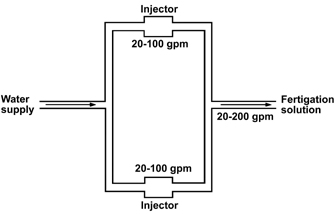 Figure 8. Parallel positioning of fertilizer injectors. Source: Water and Nutrient Management for Greenhouses (NRAES-56)
Figure 8. Parallel positioning of fertilizer injectors. Source: Water and Nutrient Management for Greenhouses (NRAES-56)Portable or stationary injector.
In small operations, it is convenient to be able to move the injector unit around, while in large operations where high volumes of fertilizer solution are regularly used at each fertigation, stationary injectors along with large stock tanks are more appropriate. In large operations divided into several greenhouse sections, growers often install an injector in each section so that different fertilizer programs can be used for different crops.
When installing a stationary injector, you may want to consider a location with limited access, such as a room with a lock, to safeguard against possible employee misconduct and any attempt to compromise your crops.
Ease of repair and longevity of the unit.
If the repair cost is equal to half or more of the cost of a new unit, replacement of an existing injector is advised. Ask manufacturer about repair policy and costs.
You may also consider purchasing a backup injector unit to be used in case of failure of the main one, or when maintenance of main unit is being performed.
Manufacturer's reliability, technical support, service and other qualifications.
Many manufacturers have Web sites with useful information about their products (see Table 4). Attend trade shows and talk to company representatives about the full range of their products and their features.
Installation Considerations
A permanently installed injector should be plumbed off the main water line (water bypass), which will permit clean water to flow through the irrigation line to purge the line of fertilizer solution or supply water to crops where fertilizer is not needed. A bypass installation also allows easy removal of the unit in case of malfunction or the need for maintenance or replacement.
Consider installation of additional equipment for optimal performance including:
- A 140 or 200-mesh filter is recommended upstream of the injector unit.
- A pressure regulator if in-line water pressure exceeds the maximum allowable for the unit. A one-way check valve may be helpful against water hammer (see "Water Hammer" below).
- A backflow valve to prevent contamination of the irrigation water supply if negative pressure occurs. These valves are mandatory in Georgia (see "Laws and Regulations Concerning Water Supply Protection.").
Some injectors come with an optional electrical conductivity meter in the water line. This makes it easy to determine whether the injector is functioning properly. Maintenance of the probes on these meters is essential to obtain correct readings. A blending tank may be needed to ensure good mixing of the water and chemicals. Whether you need a blending tank depends on the type of injector and design of the irrigation system.
Water Hammer
Water hammer is kinetic energy (momentum) present in the water that is traveling in one direction. When the water hits a closed valve, such as a solenoid valve, it comes back in the line at four times the original pressure. If you have water pressure of 50 psi in the water line, four times that comes back at your injector and 200 psi will damage it. Water hammer can be a serious problem in installations with long pipe runs, or where solenoid valves are used. Water hammer can generate pressures up to 500 psi or more! This puts stress on the whole injector (and on your entire water system), but it is especially destructive to diaphragms. To avoid this, install a simple check valve or if you have water pressure over 50 psi, an accumulator (captive air device) near your injector.
Verifying an Injector Is Working Properly
The dilution ratio should be known and adjusted as needed (see calibration methods). If large deviations (more than 5 percent) from the expected setting occur, contact the manufacturer for possible repair, replacement, or maintenance. Soluble fertilizers should be dissolved completely; use hot water if necessary but allow the solution to cool before starting the injector. Tracer dye in water-soluble fertilizers should not be used as an indicator of a solution's strength. Different fertilizer lots may have different dye contents causing variability in color intensity of fertilizer solutions. Before mixing different chemicals in the injector, consult chemical manufacturers to determine the compatibility of the products. Constant agitation is needed when applying wettable powders because they suspend but do not dissolve in water.
Stock Tanks and Mixing Tanks
Stock tanks need to be opaque. The chelating agents in fertilizer (they help to make micronutrients available to the plants) break down if exposed to light. Stock tanks should be covered to prevent algae and/or debris buildup, contamination or evaporation of stock solution. If debris build-up occurs, it may plug the injector intake and cause less than the required amount of stock solution to be taken up. The result will be low fertility and starved crops.
If the stock tank is left uncovered, some evaporation will occur, thus increasing the concentration of the stock solution to be higher than recommended. The result will be high fertility and possibly high soluble salts damage and nutrient toxicities in the crops.
Water-soluble fertilizers tend to accumulate in the bottom of stock tanks, which can result in large differences in fertilizer concentrations. If you are using a large stock tank, make sure the stock solution is mixed well before using it. A good solution is to have a mixing tank equipped with an agitator, where you would dissolve the concentrated fertilizer solution (Figure 9). If any residue forms, it would fall to the bottom of the tank. You would then siphon from the mixing tank into a working tank, into which the injector intake is placed.
 Figure 9. Setup with injector and mixing tank. Injectors eliminate the need for large stock solution tanks. Source: Water and Nutrient Management for Greenhouses (NRAES-56)
Figure 9. Setup with injector and mixing tank. Injectors eliminate the need for large stock solution tanks. Source: Water and Nutrient Management for Greenhouses (NRAES-56)Caring for an Injector
The intake strainer should be suspended 2 to 4 in. from the bottom of the solution tank to avoid siphoning undissolved concentrate. Never let the suction tube filter lie on the bottom of the stock tank. The strainer should be inspected regularly for clogs and/or cracks and the suction tube filter should be cleaned regularly. Regardless of the type of injector being used, always inject clean water after the injector has been used. The solution tank should be cleaned regularly (weekly or biweekly, depending on frequency of use) to prevent dirt and scale buildup. Inspect and service O-rings. Petroleum based lubricants (Vaseline, lanoline, WD-40, motor oil) should not be used on dosage pistons or seals. Silicon-based lubricants can be used.
If an injector will not be used for an extended period, it should be removed from service. Flush the system with clean water, either by pumping water through the unit (if not feeding acid) before removing it or by rinsing these parts after removal. The valve openings should be taped closed while still wet. This will protect the seals and prevent insects from plugging up the openings. When the injector is removed from service it should be drained completely to prevent water from freezing inside.
Calibrating an Injector
Periodic calibration is needed to ensure that an injector is operating properly. You need to perform both methods described below to obtain accurate calibration.
Input/Output Method
To determine the injection ratio of an injector, collect a known amount of fertilizer solution from the injector and then measure the quantity of concentrated fertilizer that was taken up by the injector. Determine the injection ratio using the following formula:
Dilution ratio = diluted volume ÷ stock volume
where, diluted volume is the known amount of fertilizer solution after it has passed through the injector and stock volume is the amount of concentrated fertilizer solution that was used during the test.
Start the test by turning the injector on to remove air bubbles and charge the system with the concentrated stock solution. Turn off the unit, remove the siphon tube from the stock tank and place it in a large volume (minimum of 500 milliliters) graduated cylinder. Fill the cylinder with a known volume of the concentrated stock solution. Turn on the injector and collect a known volume of diluted fertilizer solution (e.g., 5 gallons).
Example. The injector is set for a 1:50 ratio. If (in the above test) 370 ml of concentrate was used to make 5 gallons (18,925 ml) of diluted solution, the actual ratio is: 18,925 ÷ 370 = 51. This is close to expected, being off by only 1 percent. Repeat this test several times. Also check the injector manual for other ways to test your specific injector.
This method checks the functionality of the injector, e.g., if the injector is delivering at the correct injection ratio. It cannot determine if the final fertilizer concentration is correct because it cannot detect errors in mixing the fertilizer stock solution.
EC Measurement Method
This easy method of measuring electrical conductivity is commonly used for water-soluble fertilizers. It does not require collection of a large quantity of fertilizer solution and is an excellent means of periodically monitoring your fertilizer program. The critical element for this method is to follow precisely the fertilizer manufacturer's guidelines for mixing stock solutions. Fertilizer suppliers generally provide charts with EC readings of various concentrations of water-soluble fertilizer solutions.
When measuring the required quantity of fertilizer (usually given as a weight amount), use a scale to ensure the proper amount. Using other measuring means, (coffee cans, plastic cups, etc.) will result in error in fertilizer concentration due to variability in the fertilizer quantity used to make up the concentrated solution. Use only reliable, calibrated conductivity meters to ensure the accuracy of readings. Standardized conductivity solutions are available from the measuring device manufacturers and should always be kept on hand. Maintain the EC meter in good condition in order to obtain correct results (Example: change the batteries when needed.)
Start the test by collecting an on site sample of clear irrigation water. Let the water run for a few minutes to flush out pipes before collecting the sample. Measure the EC of this water sample and record it. Turn the injector on and run it for a few minutes before collecting a sample of the fertilizer solution in a clean container. Test and record the EC of the fertilizer solution.
Calculate the EC contributed by the fertilizer by the following formula:
EC FERTILIZER = EC FERTILIZER SOLUTION - EC IRRIGATION WATER
Compare this reading to a chart on the fertilizer bag label.
Example.
The injector is set for a 1:50 ratio and 10.1 oz. of 20-10-20 fertilizer for each gallon of stock mix is used at a concentration of 300 parts per million nitrogen. If (in the above test), the EC IRRIGATION WATER is 0.3 mmhos/cm and the EC FERTILIZER SOLUTION is 2.1 mmhos/cm, the actual EC FERTILIZER is 2.1 - 0.3 = 1.8 mmhos/cm.
The technical chart for this particular fertilizer lists the expected EC for 300 ppm nitrogen is 1.86 mmhos/ cm. Therefore, the actual dilution ratio is off by a factor of about 3 percent (1.86 - 1.8) / 1.8 = 0.033 x 100 = 3.3%). This calculation method gives a ballpark estimate on the fertilizer program.
Regular testing of the fertilizer EC is an effective way to monitor injector performance. Be sure to calibrate your EC meter before use. If you don't calibrate your injector, you will get poor results and make the wrong decisions concerning your fertilizer program.
Note: This method checks if the final fertilizer concentration is correct, but it cannot determine if an incorrect final concentration is due to an error in mixing the stock solution or a malfunction in the injector.
Performing the Input/Output method and the EC Measurement method will determine which problem exists through a process of elimination.
Laws and Regulations Concerning
Water Supply Protection in Georgia
Backflow is defined as the flow of water or other liquids, gasses, mixtures or other substances into the distributing pipes of potable supply water from any source or sources. Backflow is caused by higher downstream pressure in the piping system than the upstream or supply pressure.
Cross connection is defined as any actual or potential connection between a potable water system and any other source or system through which it is possible to introduce into the potable system any used water, industrial fluid, gas or other substance other than intended potable water with which the system is supplied. Bypass arrangements, jumper connections, removable sections, swivel or change-over devices through which, or because of which, backflow may occur are considered cross connections. Typical cross connections are illustrated in Figure 10.
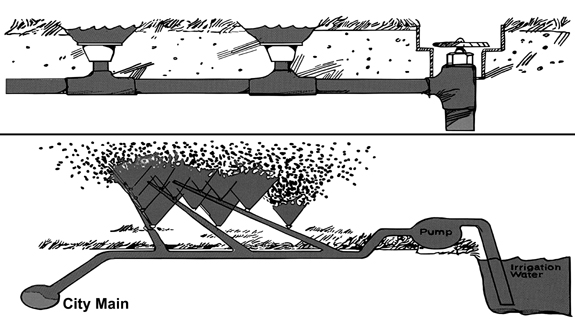 Figure 10. Examples of typical cross connections. Top: Lawn sprinklers; on a large number of lawns, the sprinkler head is below ground level. Bottom: Irrigation pumping systems connected to domestic water. In either situation, water contaminated with fertilizers and other chemicals can backflow through a leaky or partially open crossover valve. (Source: FEBCO. 1977)
Figure 10. Examples of typical cross connections. Top: Lawn sprinklers; on a large number of lawns, the sprinkler head is below ground level. Bottom: Irrigation pumping systems connected to domestic water. In either situation, water contaminated with fertilizers and other chemicals can backflow through a leaky or partially open crossover valve. (Source: FEBCO. 1977)
Backflow preventors are not required when there is a gap equal to twice the diameter of the supply line between the water line and the highest possible level of water in a mixing tank receiving the water. In such a setup, it is impossible for contaminated water to enter the water-supply line.
Georgia Anti-Siphon Device Act
Proper design of the irrigation and fertilization systems should not allow cross connections with municipal systems for any reason. Most municipal water suppliers require backflow prevention devices to prevent mixing. Check with your local water authorities concerning the current requirements. You also need to be aware of the following State Act, put forth by the Georgia Department of Agriculture:
- Any irrigation system designed or used for the application of fertilizer, pesticide, or chemicals must be equipped with an anti-siphon device adequate to protect against contamination of the water supply.
- It is unlawful for any person to use any irrigation system designed or used for the application of fertilizer, pesticide, or chemicals, which system is not equipped with an anti-siphon device.
Anti-Siphon Equipment Required
You MUST have appropriate anti-siphon equipment installed in the water supply line between the pump and the chemical injection port. The following three backflow prevention devices are all required by Georgia Anti-siphon law:
- Check Valve -- provides a positive, absolute closure of an irrigation pipe or a chemical injection line that prevents the flow of a mixture of chemicals and water to an irrigation pipe, water supply, injection device, or supply tank when operation of the irrigation system fails or is shut down.
- Low Pressure Drain -- an automatic low pressure drain valve is a self-activating device designed to immediately drain that portion of an irrigation pipe or check valve body whose contents could potentially enter the water supply when operation of the irrigation system fails or is shut down.
- Vacuum Relief Valve -- relieves or breaks vacuum in an irrigation pipe caused by system failure or shut down.
These three devices work together as a system to prevent pollution of wells. Also, most irrigation systems dealers will sell a unit that has all three valves together. In case of retrofitting an old pipeline, you might need to purchase individual components to fit into the current pipe configuration. Again, check with your local water authorities concerning current requirements for backflow prevention and consult irrigation system experts.
Bibliography
Cross Connection Control Handbook. 1977. FEBCO. Fresno, CA
Dosatron International Inc. 2002. www.dosatronusa.com
DosMatic U.S.A. Inc. 2002. www.DosMatic.com
Fertilizer Injectors Made Easy. 2001. Pennisi, B., & M. van Iersel. GMPro magazine.
Georgia Anti-Siphon Device Act. 2002. Georgia Department of Agriculture.
Greenhouse Operation and Management. Nelson, P. 1998. 5th Ed. Prentice Hall, New Jersey
H.E. Anderson Co. 2001. www.heanderson.com
Hummert International Catalog. 2003. Earth City, MO
Natural Resource, Agriculture, and Engineering Service (NRAES). 1996. Water and Nutrient Management for Greenhouses (NRAES-56). PO Box 4557, Ithaca, New York 14852-4557. Phone: (607) 255-7654. www.nraes.org
Smith Precision Products Co. 2002. Newbury Park, CA
Water and Nutrient Management for Greenhouses. 1996. NRAES-56. Ithaca, NY
Mention of a commercial or proprietary product in this publication does not constitute a recommendation by the authors, nor does it imply registration under FIFRA as amended.
Appendix
| Helpful formulas and conversions: | |
| To convert from injection ratio to percent: | To convert from percent to injection ratio: |
| (100 ÷ injection ratio) | 100 ÷ percent = injection ratio |
| Example: (100 ÷ 50) = 2% | Example: 100 ÷ 2% = 1:50 |
| Table 1. Ounces of different types of water-soluble fertilizer needed to make 1 gallon of concentrate for use with Hozon (1:16 ratio). |
| Example: If a fertilizer recommendation is 2 TBSP per gallon for final concentration, make the solution 16 times greater than the 2 TBSP rate (i.e., 16 x 2 = 32) so 32 TBSP per gallon is the concentrated rate. When mixed with water by the Hozon, the solution will come out of the hose end at the recommended rate of 2 TBSP per gallon. |
PPM of Nitrogen Desired |
|||||
| Fertilizer Analysis | 100 | 150 | 200 | 250 | 300 |
| 10-30-20 | 2.0 | 3.0 | 4.0 | 5.0 | 6.0 |
| 15-30-15 | 1.35 | 2.03 | 2.70 | 3.38 | 4.05 |
| 20-20-20 | 1.0 | 1.5 | 2..0 | 2.5 | 3.0 |
Fertilizer Calculations
Water-soluble liquid fertilizer:
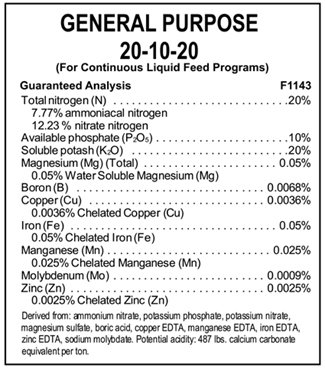
The numbers on the fertilizer bag indicate the percentage of each nutrient in it. For example -- a 20-10-20 fertilizer has 20% nitrogen, 10% phosphate and 20% potash.
Fertilizer recommendations for greenhouse crops are given as either parts per million (ppm) of a specific fertilizer nutrient or in pounds and ounces (weight basis) of a fertilizer formulation per 100 gallons of water.
Part per million (ppm) is defined as 1 part of a substance into 1 million parts of another substance.
Weight Basis
Example:
A chrysanthemum grower gets a recommendation to apply 20-20-20 water-soluble fertilizer to a final concentration of 16 oz per 100 gallons of water. How much fertilizer should be mixed in a 25-gallon stock tank if an injector with a 1:30 injection ratio will be used?
Things You Need to Know:
- Recommended fertilizer application rate: 16 oz per 100 gal
- Fertilizer formulation and analysis: 20-20-20
- Injection ratio: 1:30
- Size of stock tank in gallons: 25 gal
Solution:
Step 1: Adjust the rate for the stock tank size using the following equation.
| Equation 1 | ||
|
oz per 100 gal
100 Stock Tank Size (gal) |
= | oz fertilizer per stock tank |
|
16.0 oz per 100 gal
100/25 gal |
= | 4.0 oz of 20-20-20 per 25 gal |
Step 2: Adjust the rate for the injection ratio.
| Equation 2 |
| oz per stock tank x injector ratio = oz per stock tank using injector |
4.0 oz per 25 gal x 30 = 120.0 oz per 25 gal using 1:30 injection ratio
Parts per Million (ppm)
Example: A pansy grower gets a recommendation to apply 150 ppm nitrogen using 20-10-20 water-soluble fertilizer. How much fertilizer should be mixed in a 25-gallon stock tank if an injector with a 1:100 injection ratio will be used?
Things You Need to Know:
- Recommended fertilizer application rate: 150 ppm nitrogen
- Fertilizer formulation and analysis: 20-10-20
- Injection ratio: 1:100
- Size of stock tank: 25 gal
Solution
Step 1: Convert the ppm recommendation to a weight basis using the following equation.
| Equation 3 | ||
|
desired ppm
(% fertilizer nutrient x 0.75) |
= | oz fertilizer per 100 gal |
|
150 ppm
20% x 0.75 |
= | 10.0 oz of 20-10-20 per 100 gal |
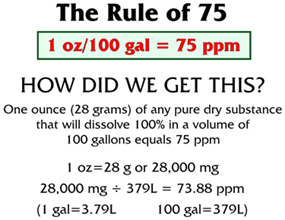
Step 2: Use equation 1 to adjust for a stock tank size of 25 gallons.
|
oz per 100 gal
100/Stock Tank Size (gal) |
= | oz fertilizer per stock tank |
|
10.0 oz per 100 gal
100/25 gal |
= | 2.5 oz of 20-10-20 per 25 gal |
Step 3: Use equation 2 to adjust the rate for a 1:100 injection ratio.
oz per stock tank x injector ratio = oz per stock tank using injector
2.5 oz per 25 gal x 100 = 250.0 oz per 25 gal using 1:100 injection ratio
Step 4: Convert ounces to pounds and ounces where, 16 oz = 1 lb (dry)
250.0 oz per 25 gal = 15 lb 10 oz 20-10-20 per 25 gal
| Table 2. Features of some commercially available injectors. | |||
| Product/Company | Injection Ratio | Flow Rate (gpm) | Inlet Pipe Diameter (in.) |
| Venturi-Continuous Injection | |||
| Pressurized stock tank + metering valve | |||
| Gewa | 1:20 - 1:300 adjustable | 1.6-88 | 0.75-1.5 |
| Nonpressurized stock tank | |||
| Hozon, Brass Siphon | Variable, 1:12 - 1:16 | Approx. 2-10 | 0.75 |
| Positive Displacement-Continuous Injection | |||
| Hydraulic pump | |||
| Smith Measuremix | 1:100, 1:200 | 3-12, 5-20, 10-40, 20-100, 50-200 | 0.75-6 |
| DosMatic | 1:50 - 1:200 adjustable | 5-20 | 0.75 |
| Dosatron | 1:50 - 1:500 adjustable | 0.5-7, 1-40, 5-100 | 0.75-2 |
| Flow metered electric pump | |||
| Anderson | Adjustable setting | 1-20, 1-30, 1.5-50, 2-100, 5-160 | 0.75-2 |
| Fert-O-Ject (E series) | 1:50, 1:100, 1:200 | 2-120 | 0.75-4 |
| B-E | Variable; optimizes EC and pH | Variable | Variable |
| Harrow | Variable; optimizes EC and pH | Variable | Variable |
| Hawe/Priva | Variable; optimizes EC and pH | Variable | Variable |
| Volmatic AMI, MGRO | Variable; optimizes EC and pH | Variable | Variable |
| Source: Water and Nutrient Management for Greenhouses (NRAES-56) | |||
| Table 3. Metric conversions. | ||
| To convert from: | To: | Multiply by: |
| Gallons | milliliters | 3875 |
| cubic feet | 0.134 | |
| liters | 3.78 | |
| Grams | ounces | 0.03 |
| Liters | fluid ounces | 33.8 |
| quarts | 1.06 | |
| gallons | 0.264 | |
| Ounces (weight) | grams | 28.35 |
| Ounces (fluid) | milliliters | 29.6 |
| liters | 0.03 | |
| Pints (fluid) | milliliters | 473 |
| liters | 0.473 | |
| Pounds | grams | 453.6 |
| Quarts (dry) | cubic inches | 67.2 |
| Quarts (fluid) | milliliters | 946 |
| liters | 0.946 | |
| Table 4. Contact information for fertilizer injector companies. | ||
| Company Name | Phone Number | Website Address |
| Dosatron International Inc. | 800-523-8499 | www.dosatronusa.com |
| DosMatic U.S.A. Inc. | 800-344-6767 | www.DosMatic.com |
| H.E. Anderson Co. | 800-331-9620 | www.heanderson.com |
| Smith Precision Products | 805-498-6616 | www.smithpumps.com |
1Extension Horticulture Specialist, The University of Georgia
2Extension Horticulture Specialist, Auburn University
Status and Revision History
Published on Nov 13, 2003
Published on Feb 27, 2009
Published on Apr 10, 2009
Published with Full Review on Apr 10, 2012
Published with Full Review on Jan 30, 2017
Published with Full Review on Nov 14, 2023
Published with Full Review on Apr 09, 2024


























































